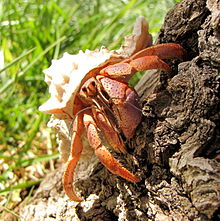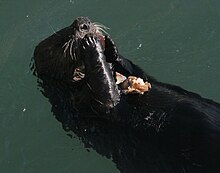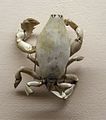| Revision as of 12:20, 16 April 2009 edit194.81.39.229 (talk)No edit summary← Previous edit | Revision as of 12:21, 16 April 2009 edit undoDecltype (talk | contribs)Administrators20,144 editsm Reverted edits by 194.81.39.229 to last revision by 75.50.107.97Next edit → | ||
| Line 1: | Line 1: | ||
| {{otheruses}} | {{otheruses}} | ||
| {{Taxobox | {{Taxobox | ||
| | name = Crabs |
| name = Crabs | ||
| | image = Blue crab on market in Piraeus - Callinectes sapidus Rathbun 20020819-317.jpg | | image = Blue crab on market in Piraeus - Callinectes sapidus Rathbun 20020819-317.jpg | ||
| | image_caption = '']'' | | image_caption = '']'' | ||
Revision as of 12:21, 16 April 2009
For other uses, see Crab (disambiguation).
| Crabs | |
|---|---|

| |
| Callinectes sapidus | |
| Scientific classification | |
| Kingdom: | Animalia |
| Phylum: | Arthropoda |
| Subphylum: | Crustacea |
| Class: | Malacostraca |
| Order: | Decapoda |
| Suborder: | Pleocyemata |
| Infraorder: | Brachyura Linnaeus, 1758 |
| Superfamilies | |
| |
Crabs are decapod crustaceans of the infraorder Brachyura, which typically have a very short projecting "tail" (Template:Lang-el = short, ουρά/οura = tail), or where the reduced abdomen is entirely hidden under the thorax. They are generally covered with a thick exoskeleton, and armed with a single pair of chelae (claws). 6,793 species are known. Crabs are found in all of the world's oceans. Additionally, there are also many freshwater and terrestrial crabs, particularly in tropical regions. Crabs vary in size from the pea crab, only a few millimetres wide, to the Japanese spider crab, with a leg span of up to 4 m.
Evolution and classification

The infraorder Brachyura contains about 93 families , as many as the remainder of the Decapoda. The evolution of crabs is characterised by an increasing robustness of the body, and a reduction in the abdomen. Although many other groups have also undergone similar processes of carcinisation, it is most advanced in crabs. The telson is no longer functional in crabs, and the uropods are absent, having probably evolved into small devices for holding the reduced abdomen tight against the sternum.

In most decapodes, the gonopores (sexual openings) are found on the legs. However, since crabs use the first two pairs of pleopods (abdominal appendages) for sperm transfer, this arrangement has changed. As the male abdomen evolved into a narrower shape, the gonopores have moved towards the midline, away from the legs, and onto the sternum. A similar change occurred, independently, with the female gonopores. The movement of the female gonopore to the sternum defines the clade Eubrachyura, and the later change in the position of the male gonopore defines the Thoracotremata. It is still a subject of debate whether those crabs where the female, but not male, gonopores are situated on the sternum form a monophyletic group.
The earliest unambiguous crab fossils date from the Jurassic, although the Carboniferous Imocaris, known only from its carapace is thought to be a primitive crab. The radiation of crabs in the Cretaceous and afterwards may be linked either to the break-up of Gondwana or to the concurrent radiation of bony fish, the main predators of crabs.
About 850 species of crab are freshwater or (semi-)terrestrial species; they are found throughout the world's tropical and semi-tropical regions. They were previously thought to be a closely related group, but are now believed to represent at least two distinct lineages, one in the Old World and one in the New World.
Behaviour
Crabs are mostly active animals with complex behaviour patterns. They can communicate by drumming or waving their pincers. Crabs tend to be aggressive towards one another and males often fight to gain access to females. On rocky seashores, where nearly all caves and crevices are occupied, crabs may also fight for the best hiding holes.
Diet
Crabs are omnivores, feeding primarily on algae , and taking any other food, including molluscs, worms, other crustaceans, fungi, bacteria and detritus, depending on their availability and the crab species. For many crabs, a mixed diet of plant and animal matter results in the fastest growth and greatest fitness .
Culinary use
Further information: Category:Crab dishesCrabs are prepared and eaten as a dish in several different ways all over the world. Some crabs are eaten whole, including the shell, as soft-shell crab; with other crabs it's just the claws and/or legs that are eaten. The latter is particularly common for larger crabs, such as the snow crab.
In some regions spices are used to improve the culinary experience of eating crab. In East Asia the chilli crab is an example of a heavily spiced dish. In Maryland, blue crab is often eaten with Old Bay Seasoning.
With the British dish dressed crab, the meat is extracted from all over the crab and placed inside the hard shell. On the other side of the Atlantic, an American way to take advantage of the crab meat is by extracting it and adding a flour mix, creating a crab cake.
Crabs are also used in soups, like in bisque, a global dish of French origin.
Live lobsters are often cooked in boiling water. Norwegian scientists addressed this ethical issue by stating that crabs don't feel pain. However, later research suggests that crustaceans are indeed able to feel and remember pain.
Fishery
Main article: Crab fisheries
Crabs make up 20% of all marine crustaceans caught and farmed worldwide, with over 1½ million tonnes being consumed annually. Of that total, one species accounts for one fifth: Portunus trituberculatus. Other important taxa include Portunus pelagicus, several species in the genus Chionoecetes, the Blue crab (Callinectes sapidus), Charybdis spp., Cancer pagurus, the Dungeness crab (Cancer magister) and Scylla serrata, each of which provides more than 20,000 tonnes annually .
Cultural influences of the crab

The Moche people of ancient Peru worshipped nature, especially the sea. They placed emphasis on animals and often depicted crabs in their art.
The Cancer Constellation is one of the 12 Zodiac signs.

Gallery
-
 Masked crab, Corystes cassivelaunus
Masked crab, Corystes cassivelaunus
-
 Liocarcinus vernalis
Liocarcinus vernalis
-
 Circular crab, Atelecyclus rotundatus
Circular crab, Atelecyclus rotundatus
-
 The terrestrial halloween crab, Geocarcinus quadratus
The terrestrial halloween crab, Geocarcinus quadratus
-
 Arrow crab Stenorhynchus seticornis
Arrow crab Stenorhynchus seticornis
-
"Sally Lightfoot", Grapsus grapsus
-
 Thumbnail crab, Thia scutellata
Thumbnail crab, Thia scutellata
-
 Japanese spider crab, Macrocheira kaempferi
Japanese spider crab, Macrocheira kaempferi
-
 Ghost crab, Ocypode quadrata
Ghost crab, Ocypode quadrata
-
 Fiddler crab, Uca pugnax
Fiddler crab, Uca pugnax
-
 Lyreidus tridentatus, a raninid
Lyreidus tridentatus, a raninid
-
 Hepatus epheliticus, a calico crab
Hepatus epheliticus, a calico crab
References
- Walters, Martin & Johnson, Jinny. The World of Animals. Bath, Somerset: Parragon, 2007.
- "Biggest, Smallest, Fastest, Deepest: Marine Animal Records". OceanLink. Retrieved 2006-09-22.
- P. K. L. Ng, D. Guinot & P. J. F. Davie (2008). "Systema Brachyurorum: Part I. An annotated checklist of extant Brachyuran crabs of the world" (PDF). Raffles Bulletin of Zoology. 17: 1–286.
- ^ Martin, J. W. & G. E. Davis (2001). An Updated Classification of the Recent Crustacea (PDF). Natural History Museum of Los Angeles County. pp. 132 pp.
- Guinot, D & J.–M. Bouchard (1998). "Evolution of the abdominal holding systems of brachyuran crabs (Crustacea, Decapoda, Brachyura)" (PDF). Zoosystema. 20 (4): 613–694.
{{cite journal}}: Unknown parameter|quotes=ignored (help) - De Saint Laurent, M. (1980). "Sur la classification et la phylogénie des Crustacés Décapodes Brachyoures. II. Heterotremata et Thoracotremata Guinto, 1977". C. R. Acad. Sc. Paris. t. 290: 1317–1320.
{{cite journal}}: Unknown parameter|quotes=ignored (help) - Schram, F. R. & R. Mapes (1984). "Imocaris tuberculata, n. gen., n. sp. (Crustacea: Decapoda) fro the upper Mississippian Imo Formation, Arkansas". Transactions of the San Diego Society of Natural History. 20 (11): 165–168.
{{cite journal}}: Unknown parameter|quotes=ignored (help) - Wägele, J. W. (1989). "On the influence of fishes on the evolution of benthic crustaceans". J. Zool. Syst. Evolut.-forsch. 27: 297–309.
{{cite journal}}: Unknown parameter|quotes=ignored (help) - Sternberg, R. von & N. Cumberlidge (2001). "On the heterotreme-thoracotreme distinction in the Eubrachyura De Saint Laurent, 1980 (Decapoda: Brachyura)". Crustaceana. 74: 321–338. doi:10.1163/156854001300104417.
{{cite journal}}: Unknown parameter|quotes=ignored (help) - Sternberg, R. von, N. Cumberlidge & G. Rodriguez (1999). "On the marine sister groups of the freshwater crabs (Crustacea: Decapoda: Brachyura)". J. Zool. Syst. Evol. Research. 37: 19–38. doi:10.1046/j.1439-0469.1999.95092.x.
{{cite journal}}: Unknown parameter|quotes=ignored (help)CS1 maint: multiple names: authors list (link) - "Crab (animal)," Encarta Encyclopedia. 2005 ed.
- The Miles Kelly Book of Life. Great Bardfield, Essex: Miles Kelly Publishing Ltd., 2006.
- Woods, C. M. C. (1993). "Natural diet of the crab Notomithrax ursus (Brachyura, Majidae) at Oaro, South Island, New Zealand". New Zealand Journal of Marine and Freshwater Research: 309=315.
{{cite journal}}: Unknown parameter|Volume=ignored (|volume=suggested) (help); Unknown parameter|quotes=ignored (help) - Kennish, R. (1996). "Diet composition influeces the fitness of the herbivorous crab Grapsus albolineatus". Oecologia (1): 22–29.
{{cite journal}}: Unknown parameter|quotes=ignored (help); Unknown parameter|volum=ignored (help) - Buck, T. L., G. A. Breed, S. C. Pennings, M. E. Chase, M. Zimmer & T. H. Carefoot (2003). "Diet choice in an omnivorous salt-marsh crab: different food types, body size, and habitat complexity". Journal of Experimental Marine Biology and Ecology. 292 (1): 103–116.
{{cite journal}}: Unknown parameter|quotes=ignored (help)CS1 maint: multiple names: authors list (link) - Scientists say lobsters feel no pain
- Crabs 'feel and remember pain' suggests new study
- "Global Capture Production 1950-2004". FAO. Retrieved 2006-08-26.
- Benson, Elizabeth, The Mochica: A Culture of Peru. New York, NY: Praeger Press. 1972
- Berrin, Katherine & Larco Museum. The Spirit of Ancient Peru:Treasures from the Museo Arqueológico Rafael Larco Herrera. New York: Thames and Hudson, 1997.
See also
|
|
External links
![]() Media related to Brachyura at Wikimedia Commons
Media related to Brachyura at Wikimedia Commons
![]() Data related to Brachyura at Wikispecies
Data related to Brachyura at Wikispecies
| Fisheries and fishing topic areas | ||
|---|---|---|
| Fisheries |  | |
| Fishing | ||
| Industry | ||
| Recreation | ||
| Techniques | ||
| Tackle | ||
| Locations | ||
| Crime | ||